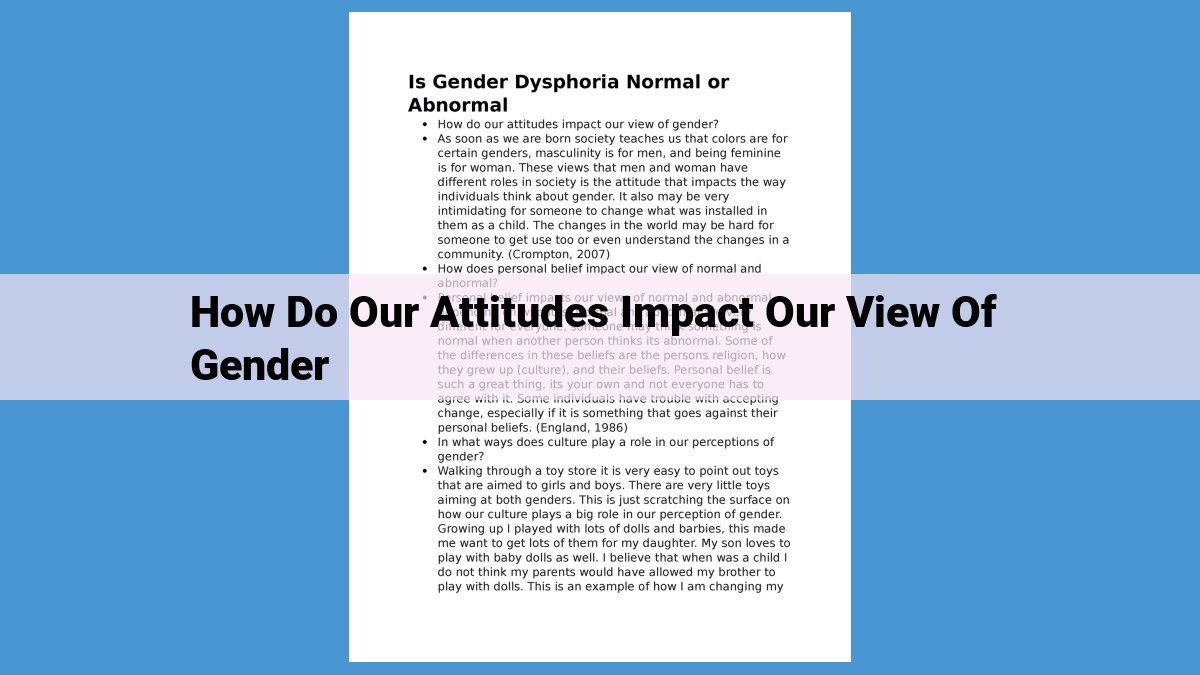Our attitudes shape our perception of gender by influencing our beliefs about gender roles, identities, and expressions. They can lead to biases, stereotypes, and discrimination that limit opportunities and well-being. Understanding the social construction of gender and the intersection of gender with other identities helps us recognize and challenge these attitudes, fostering respect and inclusivity for diverse gender experiences.
Understanding Gender Concepts
Embracing Our Diverse Identities
Gender is an intricate tapestry woven from threads of social norms, cultural expectations, and personal experiences. It shapes our perception of ourselves and the world around us, influencing our behavior, opportunities, and well-being.
Deconstructing Gender Roles and Stereotypes
Society often assigns predefined roles and behaviors to individuals based on their gender. Gender roles dictate what is considered masculine or feminine, creating a rigid system that can limit our potential. Similarly, gender stereotypes reinforce these roles, perpetuating narrow expectations that can hinder personal growth.
Challenging Gender Bias and Discrimination
Gender bias unconsciously influences our thoughts, decisions, and actions towards people of different genders. This can manifest as subtle microaggressions or overt discrimination, creating a hostile environment for those who don’t conform to societal norms. Gender-based violence is an extreme manifestation of gender inequality that disproportionately affects women and marginalized gender identities.
Recognizing the Impact of Gender
It is crucial to acknowledge the profound impact gender has on our lives. From shaping our aspirations to determining access to education, employment, and healthcare, gender can create both advantages and barriers. Understanding gender constructs empowers us to create a more inclusive and equitable society where everyone can thrive regardless of their gender identity or expression.
Gender Identity and Expression: Unraveling the Spectrum
Understanding gender encompasses more than simply biological sex. Gender identity refers to an individual’s deeply felt, internal sense of being male, female, non-binary, or another gender. It may or may not align with one’s assigned sex at birth.
Gender expression is the way individuals convey their gender identity through their words, actions, and appearance. This can include clothing, hairstyle, body language, and other forms of self-presentation. It’s important to respect and support diverse gender identities and expressions.
Everyone’s gender journey is unique, and it’s crucial to approach these conversations with empathy and understanding. Invalidating or stigmatizing individuals for their gender identity or expression can have profound negative consequences on their well-being.
Remember, gender is fluid and exists on a spectrum. It’s not just a binary of male and female but encompasses a wide range of identities and expressions. By embracing this diversity, we create a more inclusive and equitable society where everyone can live authentically without fear of judgment or discrimination.
Intersectionality: Unraveling the Complexities of Gender
Intersectionality is a groundbreaking concept that recognizes the intricate interplay between gender and other social identities, such as race, ethnicity, and sexual orientation. By acknowledging these intersecting identities, we gain a deeper understanding of the diverse experiences and challenges faced by individuals in our society.
Gender alone does not determine one’s lived experiences. For example, a woman of color may face unique forms of discrimination and marginalization that are distinct from those experienced by a white woman. Similarly, a lesbian woman may encounter societal barriers and prejudices that differ from those faced by a heterosexual woman.
This intersectionality highlights the need for inclusive policies and practices that address the interconnected challenges faced by individuals with multiple marginalized identities. By embracing diversity and fostering a sense of belonging, we can create a more just and equitable society for all.
Deconstructing Gender: The Social Construction of Identity
Gender, a concept often perceived as innate and unyielding, is in fact a social construct, molded by cultural norms, historical events, and power dynamics. This realization challenges our traditional perceptions of gender roles and opens the door to a more equitable society.
Throughout history, societal expectations have shaped the way individuals perceive gender. From the blue and pink aisles of toy stores to the contrasting expectations of male and female behavior, cultural influences have instilled in us a binary understanding of gender. Historical events have further reinforced these norms, such as the rise of patriarchy and the subjugation of women in many societies.
However, scientific advancements have shown that biological sex, while influencing certain physical attributes, does not solely determine gender. Gender identity, the deep-seated sense of one’s own gender, and gender expression, the external manifestation of gender, are fluid constructs influenced by social factors.
Challenging traditional gender roles becomes imperative when we recognize the social construction of gender. By breaking free from these binary confines, we can create a society where individuals are not limited by expectations based on their assigned sex at birth. Inclusivity and respect for diverse gender identities and expressions promote a more harmonious and equitable world.
To conclude, the social construction of gender empowers us to reshape societal perceptions and embrace a more nuanced understanding of gender. By recognizing the malleability of gender norms, we can break down barriers, foster inclusivity, and ultimately create a society where every individual is valued for their unique identity.
